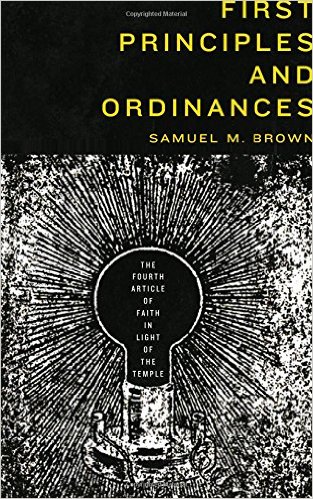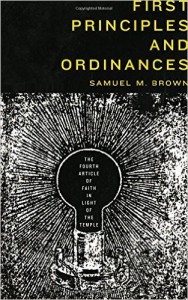Samuel Brown’s First Principles and Ordinances: The Fourth Article of Faith in Light of the Temple is not a very big book, but it took me a big time to read, and a bigger time to think about. This is in part, because I could only read in little bursts of time confetti, one page here, three pages there, on walks to the water with my daughter, or at the nearby park. But, there is a another important part: it’s pages contain multitudes. For me, this meant that it benefited from a slow read, and also that every time I turned to its pages, I felt better–not just about Mormonism, which I might have expected, but about marriage, relationships, and community, which I didn’t quite expect.
It helps to know that First Principles and Ordinances is the second book in Neal A. Maxwell Institute’s “Living Faith” series, with Adam Miller’s Letters to a Young Mormon being the first, Steven L. Peck’s Evolving Faith, being the third, and Patrick Q. Mason’s, Planted, being the fourth. (If you, like I, noticed that there are as of yet no female authors, take heart, and please consider submitting something. It is a matter the Maxwell Institute is very much aware of, and very much would like to change.)
In this series, each author approaches a matter of faith personally and professionally, meaning that they write both from their life of faith and their life of scholarship, making it a clear and worthwhile attempt at Anselm’s “faith seeking understanding.”
Brown does two (good) things that Miller did before him: he starts with something familiar (in this case, the Fourth Article of Faith), to help us see it in a new way, and, defines faith in terms of faithfulness, or fidelity.
Brown also starts many sections with a story. In the introduction, the story is his own, about coming to belief in God at 18, after a time away, through blessing the sacrament out loud, slowly and tearfully, for his patient and welcoming congregation. When I read it, I cried, too.
Other stories belong to others. Many of them belong to women, including one woman that I know–a neuroscientist, who helped care for me after the worst heartache of my life. When I read her ideas and faith, I cried again. (I found out only afterward, that Brown consciously sought to include women’s words and stories by delving into Claremont’s Mormon Women Oral History Project.)
Each story is a springboard to look more closely at a close part of the Fourth Article of Faith:
We believe that the first principles and ordinances of the Gospel are: first, Faith in the Lord Jesus Christ; second, Repentance; third, Baptism by immersion for the remission of sins; fourth, Laying on of hands for the gift of the Holy Ghost.
Faith is one chapter, and repentance another. Ordinances in general, have their own chapter, then the specific ordinances of baptism by water and fire make up two more. The last chapter is on the temple, which Brown sees as a culmination of these first principles and ordinances.
While there are so many beautiful and meaningful parts, there are approximately three that I keep coming back to. One is the faith as fidelity I mentioned earlier. This kind of faith is much more about a way of relating than it is about a list of tenets that we can check off or not. It also means that there is something active we can do about our faith: we can seek to have positive experiences with it. Another way to say this, is that the kind of faith we need to have for God and Christ (and even each other) is similar to the kind of faith we need to have for our spouses, or people we are otherwise related to in deep and abiding ways. It is about love, and care, and time, and purposefully building positive memories together. It offers another way to talk and think about faith crises.
The second is Brown’s take on the sacrament, as an agape feast God wants to have with us. It is God inviting us to share a meal, every week, indicating our closeness, that we are God’s and God is ours, in the best kind of friend/family way. The sacrament is a way for us to claim each other, for us to accept our divine birth certificate. It is also a meal we share with others, those who may actually be our brothers and sisters physically, and those who may be so only spiritually. It is a time to eat and drink with them, to simply be with them, and to remember with them, in a shared recollection of Christ’s love for us. I think about this feasting and togetherness now, on most Sunday morns. Every time I do, it helps.
The third is something simple Brown wrote about the Holy Ghost. He compared it to the wind, which I’ve heard done before, but he did it in a particularly beautiful way. He talked about how we can’t see the wind, but we can see its effects, in the trees or the water. It can be subtle or strong. So, so strong. And we can feel it.
(A fourth insightful part I was grateful to read discussed the role that depression can play on one’s ability or inability to feel the Holy Ghost.)
There is one place when Brown mentions a woman who initially has a difficult time with the temple. I both appreciated this and wished for more, because it reflects many women’s relationship with the temple. While I also loved so much that Brown said about ordinances (specifically how they are a perfect unifying of both the body and spirit, and the moment and eternity), I longed for him to acknowledge that women experience ordinances differently than those who (even outside the temple) are allowed to officiate them. He does use the phrase “Heavenly Parents” at least once (though I believe more). For that, I am always grateful.
I am similarly thankful that I read this book. It was worth all of the time confetti I was able to give. It left me more hopeful and more resolved to love my self, God, and flawed community, better.
If you have read this book, what parts most resonated with you?
What other types of books would you like to see in this series?
What other types of books would you like to write for this series? (Please, please submit them.)







4 Responses
I saw this book pop up on Amazon and was intrigued! And I love the idea of “time confetti”–well, I hate it, but I love having a vocabulary to describe something I don’t like. 🙂
I love and hate the phrase “time confetti” for the same reasons. 🙂 And the book is really such a beautiful book. I want every Mormon to read it.
Great review Rachel! This has interested me in the whole series. It sounds like a beautiful, thought provoking book.
[…] was an unusual book for me to review. First off, our own Rachel had already done a review of it. Secondly, my own physical location made the book an unusual thesis for examination as one of the […]